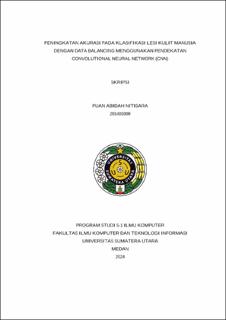Peningkatan Akurasi pada Klasifikasi Lesi Kulit Manusia dengan Data Balancing Menggunakan Pendekatan Convolutional Neural Network (CNN)
Enhancing Accuracy in the Classification of Human Skin Lesion through Data Balancing Using Convolutional Neural Network (CNN) Approach

Date
2024Author
Nitisara, Puan Abidah
Advisor(s)
Amalia
Purnamasari, Fanindia
Metadata
Show full item recordAbstract
Skin lesion is a part of the skin with an abnormal appearance or growth, which can be categorized as benign or malignant. Early diagnosis of skin lesions is essential to determine appropriate treatment, but visual classification of skin lesions is challenging due to visual similarities between lesions. Although dermatologists use a dermatoscope to examine lesions, diagnosis is often subjective and influenced by various factors, such as image quality and the physical condition of the dermatologist. Therefore, the development of a computer-based automated diagnosis system is necessary to improve the consistency and accuracy of results. This research develops a skin lesion classification system using deep learning method with DenseNet121 architecture, which is applied to HAM10000 dataset. The main problem in this research is the imbalance in the amount of data in each class in the dataset. To address this issue, research was conducted on the original dataset as well as on datasets where data balancing techniques, such as SMOTE (Synthetic Minority Oversampling Technique) and Data Augmentation, were applied to mitigate data imbalance. The results indicated the highest accuracy on the dataset that applied the SMOTE technique, with a training accuracy of 96.48% and a training loss of 0.101, a validation accuracy of 94.01% and a validation loss of 0.2463, and a testing accuracy of 93.20% with a testing loss of 0.2341. This model is then integrated into a web-based application to facilitate user detection of the type of skin lesion based on the entered dermoscopy image.
Collections
- Undergraduate Theses [1253]
